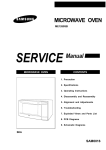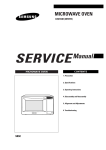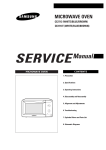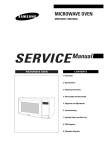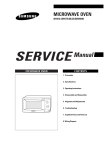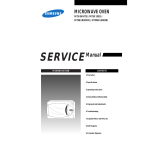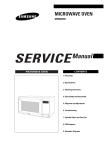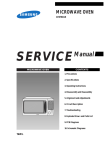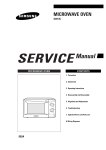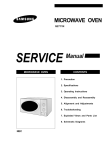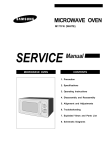Download Samsung M1733 Service manual
Transcript
MICROWAVE OVEN
M1732 / M1733
SERVICE
Manual
MICROWAVE OVEN
CONTENTS
1. Precaution
2. Specifications
3. Operating Instructions
4. Disassembly and Reassembly
M1732
5. Alignment and Adjustments
6. Troubleshooting
7. Exploded Views and Parts List
8. PCB Diagrams
M1733
9. Schematic Diagrams
1. Precaution
Follow these special safety precautions. Although the microwave oven is completely safe during ordinary
use, repair work can be extremely hazardous due to possible exposure to microwave radiation, as well as
potentially lethal high voltages and currents.
1-1 Safety precautions (
)
1. All repairs should be done in accordance
with the procedures described in this
manual. This product complies with
Federal Performance Standard 21 CFR
Subchapter J (DHHS).
2. Microwave emission check should be
performed to prior to servicing if the oven is
operative.
3. If the oven operates with the door open :
Instruct the user not to operate the oven and
contact the manufacturer and the center for
devices and radiological health immediatly.
4. Notify the Central Service Center if the
microwave leakage exceeds 5 mW/cm2
5. Check all grounds.
6. Do not power the MWO from a "2-prong"
AC cord. Be sure that all of the built-in
protective devices are replaced. Restore any
missing protective shields.
7. When reinstalling the chassis and its
assemblies, be sure to restore all protective
devices, including: nonmetallic control
knobs and compartment covers.
8. Make sure that there are no cabinet openings
through which people--particularly
children--might insert objects and contact
dangerous voltages. Examples: Lamp hole,
ventilation slots.
9. Inform the manufacturer of any oven found
to have emmission in excess of 5 mW/cm2,
Make repairs to bring the unit into
compliance at no cost to owner and try to
determine cause.
Instruct owner not to use oven until it has
been brought into compliance.
CENTRAL SERVICE CENTER
10. Service technicians should remove their
watches while repairing an MWO.
Samsung Electronics
11. To avoid any possible radiation hazard,
replace parts in accordance with the wiring
diagram. Also, use only the exact
replacements for the following parts:
Primary and secondary interlock switches,
interlock monitor switch.
12. If the fuse is blown by the Interlock Monitor
Switch: Replace all of the following at the
same time: Primary and secondary switches,
as well as the Interlock Monitor Switch. The
correct adjustment of these switches is
described elsewhere in this manual. Make
sure that the fuse has the correct rating for
the particular model being repaired.
13. Design Alteration Warning:
Use exact replacement parts only, i.e.,
only those that are specified in the
drawings and parts lists of this manual.
This is especially important for the
Interlock switches, described above.
Never alter or add to the mechanical or
electrical design of the MWO. Any design
changes or additions will void the
manufacturer's warranty.10.Always unplug
the unit's AC power cord from the AC
power source before attempting to
remove or reinstall any component or
assembly.
14. Never defeat any of the B+ voltage
interlocks. Do not apply AC power to the
unit (or any of its assemblies) unless all
solid-state heat sinks are correctly installed.
15. Some semiconductor ("solid state") devices
are easily damaged by static electricity. Such
components are called Electrostatically
Sensitive Devices (ESDs). Examples include
integrated circuits and field-effect
transistors.
Immediately before handling any
semiconductor components or assemblies,
drain the electrostatic charge from your
body by touching a known earth ground.
16. Always connect a test instrument's ground
lead to the instrument chassis ground before
connecting the positive lead; always remove
the instrument's ground lead last.
1-1
Pretaution
1-2 Special Servicing Precautions (Continued)
17. When checking the continuity of the witches
or transformer, always make sure that the
power is OFF, and one of the lead wires is
disconnected.
18. Components that are critical for safety are
indicated in the circuit diagram by
shading,
or
.
19. Use replacement components that have the
same ratings, especially for flame resistance
and dielectric strength specifications. A
replacement part that does not have the
same safety characteristics as the original
might create shock, fire or other hazards.
1-3 Special High Voltage Precautions
1. High Voltage Warning
Do not attempt to measureany of the high
voltages--this includes the filament voltage
of the magnetron. High voltage is present
during any cook cycle.
Before touching any components or wiring,
always unplug the oven and discharge the
high voltage capacitor (See Figure 1-1)
2. The high-voltage capacitor remains charged
about 30 seconds after disconnection. Short
the negative terminal of the high-voltage
capacitor to to the oven chassis. (Use a
screwdriver.)
3. High voltage is maintained within specified
limits by close-tolerance, safety-related
components and adjustments. If the high
voltage exceeds the specified limits, check
each of the special components.
Fig. 1-1. Discharging the High Voltage Capacitor
1-2
Samsung Electronics
2. Specifications
2-1 Table of Specifications
TIMER
99 MINUTES 90 SECONDS
POWER SOURCE
230V 50Hz, AC
POWER CONSUMPTION
MICROWAVE : 1,200W
OUTPUT POWER
FROM 100 TO 800W
(IEC-705 TEST PROCEDURE)
OPERATING FREQUENCY
2,450MHz
MAGNETRON
OM75SH(31)
COOLING METHOD
COOLING FAN MOTOR
OUTSIDE DIMENSIONS
489(W) x 275(H) x 351(D)
2-2 Comparison Chart
MODEL
FEATURE
Samsung Electronics
M1732 / M1733
HOLD TIMER
O (M1733)
MORE/LESS
-
AUTO COOK/DISH
-
AUTO DEFROST
O
TIME COOK
O
POWER LEVEL
O
INSTANT COOK
O
MEMORY
-
BOOST
O
CHILD LOCK
-
CLOCK
O
GRILL
-
COMBI
-
2-1
3. Operating Instructions
3-1 Control Panel
M1732
M1733
2
4
1. Clock Setting
2. Instant Reheat Selection
3. Weight Selection
4. Auto Deforst Feature Selection
5. Timer Setting and Serving Selection
6. Microwave Mode Selection
7. Start Button
8. Stop/Cancel Button
3
5
6
1
7
8
3-2 Features & External Views
VENTILATION HOLES
LIGHT
OPEN DOOR
PUSH BUTTON
TURNTABLE
DOOR
ROLLER RING
COUPLER
SAFETY
INTERLOCK HOLES
275mm
DOOR
LATCHES
200mm
357mm
489mm
Samsung Electronics
351mm
3-1
4. Disassembly and Reassembly
4-1 Replacement of Magnetron, Motor Assembly and Lamp
Remove the magnetron including the shield case,
permanent magnet, choke coils and capacitors (all
of which are contained in one assembly).
Cover Air
Thermo S/W
Lamp
1. Disconnect all lead wires from the magnetron
and lamp.
2. Remove a screw securing air cover.
3. Remove the air cover.
4. Remove screws securing the magnetron to the
wave guide.
5. Take out the magnetron very carefully.
6. Remove nuts from the back panel.
7. Take out the fan motor.
8. Remove the oven lamp by rotating to pull out
from hole of air cover.
NOTE1: When removing the magnetron, make
sure that its antenna does not hit any
adjacent parts, or it may be damaged.
NOTE2: When replacing the magnetron, be sure
to remount the magnetron gasket in
the correct position and make sure the
gasket is in good condition.
Fan Motor
Magnetron
Screw
H. V. Trans
H. V. Capacitor
4-2 Replacement of High Voltage Transformer
1. Discharge the high voltage capacitor.
2. Disconnect all the leads wire.
3. Remove the mounting bolts.
4. Reconnect the leads correctly and firmly.
H. V. Trans
Screws
Samsung Electronics
4-1
Disassembly and Reassembly
4-3 Replacement of Door Assembly
4-3-1 Removal of Door "C"
Insert flat screwdriver into the gap between Door
"A" and Door "C" to remove Door "C". Be careful
when handling Door "C" because it is fragile.
Then remove the door assembly.
Door "A"
Door "C"
4-3-2 Removal of Door "E"
Following the procedure as shown in the figure,
insert and bend a thin metal plate between Door
"E" and Door "A" until you hear the 'tick' sound.
Door "E"
¥ Insertion depth of the thin metal plate should be
0.5mm or less.
4-3-3 Removal of Key Door & Spring
Door "E"
Remove pin hinge from Door "E"
Detach spring from Door "E" and key door.
Key Door
4-2
Spring
Samsung Electronics
Disassembly and Reassembly
4-3-5 Reassembly Test
After replacement of the defective component parts of the door, reassemble it and follow the instructions below for proper
installation and adjustment so as to prevent an excessive microwave leakage.
1. When mounting the door to the oven, be sure to adjust the door parallel to the bottom line of the oven
face plate by moving the upper hinge and lower hinge in the direction necessary for proper alignment.
2. Adjust so that the door has no play between the inner door surface and oven front surface. If the door
assembly is not mounted properly, microwave energy may leak from the space between the door and
oven.
3. Do the microwave leakage test.
4-4 Replacement of Fuse
1. Disconnect the oven from the power source.
2. Remove the 10A fuse in the noise filter.
3. When replacing the 10A fuse, be sure to use an exact replacement part. If new 10A fuse blows out again
after replacement, check the primary interlock switch, door sensing switch and interlock monitor switch.
4. When the above three switches operate properly, check if any other part such as the control circuit board,
blower motor or high voltage transformer is defective.
4-5 Replacement of Drive Motor
1. Take out the glass tray, guide roller and coupler from
cavity.
Screw
Drive Motor
2. Turn the oven upside down to replace the drive motor.
3. Remove a screw securing the drive motor cover.
4. Disconnect all the lead wires from the drive motor.
5. Remove screws securing the drive motor to the cavity.
6. Remove the drive motor.
7. When replacing the drive motor, be sure to remount it
in the correct position.
8. Connect all the leads to the drive motor.
Drive Motor Cover
Base Plate
9. Screw the deive motor cover to the base plate with a
screw driver.
10. Remount the coupler in the correct position.
Samsung Electronics
4-3
Disassembly and Reassembly
4-6 Replacement of Control Circuit Board
4-6-1 Removal of Control Box Assembly
1. Be sure to ground any static electric charge in
your body and never touch the control circuit.
2. Disconnect the connectors from the control
circuit board.
Screw
3. Remove screws securing the control box
assembly.
4. Remove the screw securing the ground tail of the
keyboard.
Control Box
4-6-2 Removal of P.C.B Assembly
1. Pull the lever end of the plastic fastener and
remove the Flexible Printed Circuit(FPC) of
membrane panel.
2. Remove screw securing the control circuit board.
3. Lift up the control circuit board from the Ass'y
control box.
Screw
FPC Connector
4. When reconnecting the FPC connector, make sure
that the holes on the connector are properly
engaged with the hooks on the Plastic Fastener.
4-6-3 Removal of Window Display & Membrane Panel
1. Window display should not be disassembled as
its mounting tabs will be broken. If repair work
is difficult, replace with Ass'y control panel.
2. The membrane key board is attached to the
escutcheon base with doublefaced adhesive
tape. Therefore, applying hot air such as using of
hair dryer is recommended for smoother
removal.
3. When installing new membrane key board, make
sure that the surface of escutcheon base is
cleaned sufficiently so that any problems
(shorted contacts or uneven surface) can be
avoided.
SWITCH
Membrane
4-4
Samsung Electronics
5. Alignment and Adjustments
PRECAUTION
1. High voltage is present at the high voltage terminals during any cook cycle.
2. It is neither necessary nor advisable to attempt measurement of the high voltage.
3. Before touching any oven components or wiring, always unplug the oven from its power source and discharge the high voltage
capacitor.
5-1 High Voltage Transformer
1. Remove connectors from the transformer terminals
and check continuity.
2. Normal resistance readings are as follows:
MODEL
Secondary
Filament
Primary
Filament Terminals
M1732 / M1733
Approx. 123W
Approx.0W
Approx.1.8W
(Room temperature = 20ûC)
Secondary
Terminal
Primary
Terminals
5-2 Low Voltage Transformer
1. The low voltage transformer is located on the
control circuit board.
2. Remove the low voltage transformer from the
PCB Ass'y and check continuity.
3. Normal resistor reading is shown in the table.
Terminals
1~2(Input)
3~4(Output 7V)
5~6(Output17V)
Resistance
1,201W
4.348W
21.72W
5-3 Magnetron
1. Continuity checks can indicate only an open
filament or a shorted magnetron. To diagnose an
open filament or shorted magnetron :
2. Isolate the magnetron from the circuit by
disconnecting its leads.
3. A continuity check across the magnetron filament
terminals should indicate one ohm or less.
4. A continuity check between each filament terminal
and magnetron case should read open.
Magnetron Antenna
Gasket Plate
Cooling Fins
Samsung Electronics
5-1
Alignment and Adjustments
5-4 High Voltage Capacitor
1. Check continuity of the capacitor with the meter set at the highest resistance scale.
2. Once the capacitor is charged, a normal capacitor shows continuity for a short time, and then indicates 9MW.
3. A shorted capacitor will show continuous continuity.
4. An open capacitor will show constant 9MW.
5. Resistance between each terminal and chassis should read infinite.
5-5 High Voltage Diode
1. Isolate the diode from the circuit by disconnecting its leads.
2. With the ohm-meter set at the highest resistance scale, measure across the diode terminals. Reverse the
meter leads and read the resistance. A meter with 6V, 9V or higher voltage batteries should be used to
check the front-to back resistance of the diode (otherwise an infinite resistance may be read in both
directions). The resistance of a normal diode will be infinite in one direction and several hundred KW in
the other direction.
5-6 Main Relay and Power Control Relay
1. The relays are located on the PCB Ass'y. Isolate them from the main circuit by disconnecting the leads.
2. Operate the microwave oven with a water load in the oven. Set the power level set to high.
3. Check continuity between terminals of the relays after the start pad is pressed.
5-7 Adjustment of Primary Switch, Door Sensing Switch and Monitor Switch
Precaution
For continued protection against radiation hazard, replace parts in accordance with the wiring diagram and be sure to use the
correct part number for the following switches: Primary and secondary interlock switches, and the interlock monitor switch
(replace all together). Then follow the adjustment procedures below. After repair and adjustment, be sure to check the continuity
of all interlock switches and the interlock monitor switch.
1. When mounting Primary switch and Interlock
Monitor switch to Latch Body, consult the
figure.
Primary Interlock Switch
2. No specific adjustment during installation of
Primary switch and Monitor switch to the latch
body is necessary.
3. When mounting the Latch Body to the oven
assembly, adjust the Latch Body by moving it so
that the oven door will not have any play in it.
Check for play in the door by pulling the door
assembly. Make sure that the latch keys move
smoothly after adjustment is completed.
Completely tighten the screws holding the Latch
Body to the oven assembly.
4. Reconnect to Monitor switch and check the
continuity of the monitor circuit and all latch
switches again by following the components test
procedures.
5. Confirm that the gap between the switch
housing and the switch actuator is no more than
0.5mm when door is closed.
5-2
Interlock
Secondaryr
Switch
Lever Door(B)
Body Latch
Door Sensing
Switch
Primary switch
Monitor switch (COM-NC)
Monitor switch (COM-NO)
Door Sensing S/W
Door Open
¥
0
¥
¥
Door Closed
0
¥
0
0
Samsung Electronics
Alignment and Adjustments
5-8 Output Power of Magnetron
CAUTION
MICROWAVE RADIATION
PERSONNEL SHOULD NOT ALLOW EXPOSURE TO MICROWAVE RADIATION FROM MICROWAVE GENERATOR OR OTHER PARTS
CONDUCTING MICROWAVE ENERGY.
The output power of the magnetron can be measured by performing a water temperature rise test.
Equipment needed :
* Two 1-liter cylindrical borosilicate glass vessel (Outside diameter 190 mm)
* One glass thermometer with mercury column
NOTE: Check line voltage under load. Low voltage will lower the magnetron output. Make all temperature
and time tests with accurate equipment.
1. Fill the one liter glass vessel with water.
2. Stir water in glass vessel with thermometer, and record glass vessel's temperature ("T1", 10±1ûC).
3. After moving the water into another glass vessel, place it in the center of the cooking tray. Set the oven to high
power and operate for 55 seconds exactly. (2 seconds included as a holding time of magnetron oscillation:)
4. When heating is finished, stir the water again with the thermometer and measure the temperature ("T2").
5. Subtract T1 from T2. This will give you the water temperature rise. (DT)
6. The output power is obtained by the following formula;
Output Power =
4.187 x 1000 x DT
52
52 : Heating Time (sec)
4.187 : Coefficient for Water
1000 : Water (cc)
DT : Temperature Rise (T2-T1)
* Output (W) = 100 x DT
7. Normal temperature rise for this model is 9ûC to 11ûC at 'HIGH'.
NOTE 1: Variations or errors in the test procedure will cause a variance in the temperature rise.
Additional power test should be made if temperature rise is marginal.
NOTE 2: Output power in watts is computed by multiplying the temperature rise (step E) by a factor of 91
times the of centigrade temperature.
5-9 Microwave Heat Distribution - Heat Evenness
The microwave heat distribution can be checked indirectly by measuring the water temperature rise at
certain positions in the oven:
1. Prepare five beakers made of 'Pyrex', having 100 milliliters capacity each.
2. Measure exactly 100milliliters off water load with a measuring cylinder, and pour into each beaker.
3. Measure the temperature of each water load. (Readings shall be taken to the first place of decimals.)
4. Put each beaker in place on the cooking tray as illustrated in figure below. Start heating.
5. After heating for 2 minutes, measure the water temperature in each beaker.
6. Microwave heat distribution rate can be calculated as follows:
Heat Distribution =
Minimum
Temperature Rise
Maximum
Temperature Rise
D
X 100(%)
Beaker
D
D/4
The result should exceed 65%.
D/4
D/4
D/4
Samsung Electronics
Cooking Tray
5-3
Alignment and Adjustments
5-10 Procedure for Measurement of Microwave Energy Leakage
1) Pour 275±15cc of 20±5ûC(68±9ûF) water in a beaker
which is graduated to 600cc, and place the beaker in
the center of the oven.
2) Start to operate the oven and measure the leakage by
using a microwave energy survey meter.
3) Set survey meter with dual ranges to 2,450MHz.
4) When measuring the leakage, always use the 2 inch
spacer cone with the probe. Hold the probe
perpendicular to the cabinet door. Place the spacer
cone of the probe on the door and/or cabinet door
seam and move along the seam, the door viewing
window and the exhaust openings moving the probe
in a clockwise direction at a rate of 1 inch/sec. If the
leakage testing of the cabinet door seam is taken near a corner of the door, keep the probe perpendicular to
the areas making sure that the probe end at the base of the cone does not get closer than 2 inches to any
metal. If it gets closer than 2 inches, erroneous readings may result.
5) Measured leakage must be less than 4mW/cm2, after repair or adjustment.
Maximum allowable leakage is 5mW/cm2.
4mW/cm2 is used to allow for measurement and meter accuracy
5-11 Check for Microwave Leakage
1. Remove the outer panel.
2. Pour 275±15cc of 20±5ûC(68±9ûF) water in a
beaker which is graduated to 600cc, and
place the beaker in the center of the oven.
3. Start the oven at the highest power level.
4. Set survey meter dual ranges to 2,450MHz.
5. Using the survey meter and spacer cone as
described above, measure arnear the
opening of magnetron, the surface of the air
guide and the surface of the wave guide as
shown in the following photo.( but avoid the
high voltage components.) The neading
should be less than 4mW/cm2.
5-12 Note on Measurement
1) Do not exceed the limited scale.
2) The test probe must be held on the grip of the handle, otherwise a false reading may result when the
operator's hand is between the handle and the probe.
3) When high leakage is suspected, do not move the probe horizontally along the oven surface; this may
cause damage to the probe.
4) Follow the recommendation of the manufacturer of the microwave energy survey meter.
5-13 Leakage Measuring Procedure
5-13-1 Record keeping and notification after measurement
1) After adjustment and repair of a radiarion preventing device, make a repair record for the measured
values, and keep the data.
2) If the radiation leakage is more than 4 mW/cm2 after determining that all parts are in good condition,
functioning properly and the identical parts are replaced as listed in this manual notift that fact to ;
CENTRAL SERVICE CENTER
5-13-2 At least once a year have the microwave energy survey meter checked for accuracy by its manufacturer.
5-4
Samsung Electronics
6. Troubleshooting
PRECAUTION
1. CHECK GROUNDING BEFORE CHECKING FOR TROUBLE.
2. BE CAREFUL OF THE HIGH VOLTAGE CIRCUIT.
3. DISCHARGE THE HIGH VOLTAGE CAPACITOR.
4. WHEN CHECKING THE CONTINUITY OF THE SWITCHES OR TRANSFORMER, DISCONNECT ONE LEAD WIRE FROM THESE
PARTS AND THEN CHECK CONTINUITY WITHOUT THE POWER SOURCE ON. TO DO OTHERWISE MAY RESULT IN A FALSE
READING OR DAMAGE TO YOUR METER.
5. DO NOT TOUCH ANY PART OF THE CIRCUIT OR THE CONTROL CIRCUIT BOARD, SINCE STATIC DISCHARGE MAY DAMAGE IT.
ALWAYS TOUCH GROUND WHILE WORKING ON IT TO DISCHARGE ANY STATIC CHARGE BUILT UP.
6-1 Electrical Maltunction
SYMPTOM
CAUSE
CORRECTIONS
Oven is dead.
1. Open or loose lead wire harness
Fuse is OK.
2. Open thermal cutout (Magnetron)
No display and no operation at all. 3. Open low voltage transformer
4. Defective Ass'y PCB
Check fan motor when thermal cutout is defective.
No display and no operation at all. 1. Shorted lead wire harness
Fuse is blown.
2. Defective primary latch switch (NOTE 1)
3. Defective monitor switch (NOTE1)
4. Shorted HVCapacitor
5. Shorted HVTransformer (NOTE2)
Check adjustment of primary, interlock monitor,
door sensing switch.
Check Ass'y PCB when LVT is defective.
NOTE 1: All of these switches must be replaced at the same time.
(refer to adjustment instructions)
Check continuity of power relay contacts and if it has continuity, replace power
relay also.
NOTE 2: When HVTransformer is replaced, check diode and magnetron also.
Oven does not accept
key input (Program)
Timer starts countdown but no
microwave oscillation.
(No heat while oven lamp and
fan motor turn on.)
Samsung Electronics
1. Key input is not in-Sequence
2. Open or loose connection of membrane
key pad to Ass'y PCB
3. Shorted or open membrane panel
4. Defective Ass'y PCB
Refer to operation procedure.
1. Off-alignment of latch switches
2. Open or loose connection of high voltage
circuit especially magnetron filament
circuit
NOTE: Large contact resistance will bring
lower magnetron filament voltage and
cause magnetron to lower output and/or
intermittent oscillation.
3. Defective high voltage components
H.V.Transformer
H.V.Capacitor
H.V.Diode, H.V.Fuse
Magnetron
4. Open or loose wiring of power relay
5. Defective primary latch switch
6. Defective power relay or Ass'y PCB
Adjust door and latch switches.
Replace PCB main.
Check high voltage component according to
component test procedure and replace if it is
defective.
Replace PCB main.
6-1
Troubleshooting
6-1 Electrical Maltunction(continved)
SYMPTOM
CAUSE
CORRECTIONS
Oven lamp and fan motor turn on
1. Misadjustment or loose wiring
of primary latch switch
2. Defective primary latch switch
Adjust door and latch switches.
Oven can program but timer
does not start.
1. Open or loose wiring of secondary
interlock switch
2. Off-alignment of primary interlock
3. Defective secondary interlock S/W
Adjust door and interlock switches.
Microwave output is low;.
Oven takes longer time to
cook food.
1. Decrease in power source voltage.
2. Open or loose wiring of magnetron
filament circuit. (Intermittent oscillation))
3. Aging of magnetron
Consult electrician.
Fan motor turns on when plugged in
Loose wiring of door sensing switch
Check wire of door sensing switch.
Oven does not operate and return
to the plugged in mode.
Defective Ass'y PCB
Replace PCB main.
Loud buzzing noise can be heard.
1. Loose fan and fan motor
2. Loose screws on H.V.Transformer
3. Shorted H.V.Diode
Tighten screws of fan motor.
Tighten screws of H.V.Transformer.
Replace H.V.Diode.
Turntable motor does not rotate.
1. Open or loose wiring of turntable motor.
2. Defective turntable motor.
Replace turntable motor.
Oven stops operation during cooking
1. Open or loose wiring of primary
interlock switch
2. Operation of thermal cutout(Magnetron)
Adjust door and latch switches.
Sparks
1. Metallic ware or cooking dishes
touching on the oven wall.
2. Ceramic ware trimmed with gold or
silver powder also causes sparks.
Inform the customer.
Do not use any type of cookware with
metallic trimming.
Uneven cooking
Uneven intensity of microwave due to
its characteristics.
Wrap thinner parts of the food with
aluminum foil.
Use plastic wrap or cover with a lid.
Stir once or twice while cooking
foods such as soup, cocoa, or milk.
Noise from the turntable motor
when it starts to operate.
Noise may result from the motor.
Replace turntable motor.
6-2
Samsung Electronics
7. Exploded Views and Parts List
7-1 Exploded Views
D3
M1733
D4
D2
D1
M1
D6
D5
M33
M28
M32
M2
M5
M3
M1732
D4
D1
M6
D2
M4
M7
M8
D3
M10
M30
M29
M9
M11
D6
D5
M19
M27
M1733
M15
M12
M13
M12
M14
M20
C5
C4
C6
C7
M17
M21
C3
C2
C1
M16
M24
M18
M23
M26
C4
M 31
M22
M25
C5
C6
M1732
C7
C3
C2
C1
Samsung Electronics
7-1
Exploded Views and Parts List
7-2 Main Parts List M1732/M1733
Ref. No.
Parts No.
M1
M2
M3
M4
M5
M6
M7
M8
M9
M10
M11
M12
DE70-30116W
DE96-00007A
DE71-60467A
DE96-00031A
DE39-20145A
DE39-00020A
DE47-20009A
DE03-30029A
DE71-60457A
4713-001004
DE93-20101A
3405-000178
PANEL-OUTER;SECC,T0.5,W351.7,L1014.7,WHT,M
ASSY NOISE FILTER;SN-3WEA,250V10A,3W INRUSH TC
COVER-BLOWER;PP,-,-,-,-,3RD-0.7
ASSY MOTOR-FAN;SMF-3RDEA,230V50HZ,2400RPM,M1733
ASSY POWER CORD;MOONSUNG,-,230V50Hz,-,-,-,M308
WIRE HARNESS-A;M1733
THERMOSTAT;PW2N-520PB,160/60,250V/7.5A,H,
MAGNETRON;OM75SH(31)ESS
COVER-AIR;PP,T1.7,W115.5,L150,WHT,3RD-W0
LAMP-INCANDESCENT;230V,-,40W,ORG,-,-,25x71mm
ASSY BODY LATCH;3RD-0.7,P/BUTTON,PP
SWITCH-MICRO;250V,15A,200gf,SPST-NO
1
1
1
1
1
1
1
1
1
1
1
2
M13
M14
M15
M16
M17
M18
M19
M20
M21
M22
M23
M24
M25
M26
M27
M28
M29
M30
3405-000175
DE66-90114A
DE66-40001C
DE74-20102B
DE92-90436C
DE67-60075A
DE73-90027A
2501-001011
DE61-50106A
DE59-40001A
DE91-70061B
DE26-10158A
DE80-10003B
DE61-40017A
DE31-10154A
DE47-20173A
DE66-90113A
DE71-60450B
SWITCH-MICRO;250V,15A,200gf,SPST-NO
LEVER-S/W;PP(FB53WH),-,-,-,3.5G,NTR,3RD-W MW5592W
LATCH-BODY;PP(FB53WH),-,39.2G,NTR,-,3RD-W MW5592W
TRAY-COOKING;GLASS,T5.0,PI288,780G,M745
ASSY-GUIDE ROLLER;MW4370W,D16.5,XAREX
COUPLER;PPS,7G,BRN,M97G45
FERRITE-CORE;NI-ZN,T13.8,W21.0,L28.0,BNF-14
C-OIL;910nF,2100V,BK,54x35x75mm,20mm
BRACKET-HVC;SECC,T0.8,W31,L125.8,
DIODE-H.V;HVR-1X-32B-12
ASSY-H.V.FUSE;THV060T-0750-H,5KV0.75A,RED
TRANS-H.V;SHV-173EC,230V,2220/3.40V,50Hz
BASE-PLATE;SGCC1-Z,T0.8,W340,L550,3RD-0.7
FOOT;PP(A353),BLK,MW5630T,
MOTOR-DRIVE;M2HJ49ZR02,ST-16,50/60HZ,THERMOSTAT;PW-2N(90/60)30,187Y,250V7.5A,9
LEVER-DOOR;PP(TB53-GH10),T2.5,W31X100.5,-,12G,NTR,3RD-W
COVER-MGT;PP,T2,W110.5,L109,-,28G,3RD-0.7
1
1
1
1
1
1
1
1
1
1
1
1
1
2
1
1
1
1
M31
DE94-00085A
ASSY CONTROL-BOX;230V50HZ,M1732/XEG,WHT,3RD S1
1
M1732
M31
DE94-00088A
ASSY CONTROL-BOX;230V50HZ,M1733/XEG,3RD-0.7CU.FT(S2)
1
M1733
M32
DE94-00086A
ASSY DOOR;M1732/XEG,P/WHT,3RD-0.7CU.FT(S1)
1
M1732
M32
DE94-00089A
ASSY DOOR;M1733/XEG,P/WHT,3RD-0.7CU.FT(S2)
1
M1733
M33
3601-000448
FUSE-FERRULE;250V,10A,SLOW-BLOW,CERAMIC,6.3
1
: Option Parts
7-2
Description/Specification
: Warning
Q'ty
Remarks
MGT
CAVITY
:Electrostatically Sensitive Devices
Samsung Electronics
Exploded Views and Parts List
7-3 Door Parts List M1732
Ref. No.
Parts No.
D1
D2
D3
D4
D5
D6
DE64-40316B
DE67-20196A
DE94-00124B
DE64-40008B
DE64-40006A
DE61-70033A
Description/Specification
DOOR-A;TDS,-,-,-,-,M1732/12
SCREEN-DOOR;S1,-,-,-,-,3RD-0.7
ASSY DOOR-SUB;MW4593G,BLK,3RD-0.7
DOOR-C;PP,T1.5,BLK,CE745G
DOOR-KEY;POM(TC3005),T2.0,12GR,BLK,CE94
SPRING-KEY;ES,HSWR10,PI0.6,D6.0,L22.3,BLU
Q'ty
Remarks
1
1
1
1
1
1
7-3 Door Parts List M1733
Ref. No.
D1
D2
D3
D4
D5
D6
Parts No.
DE64-40322A
DE67-20186A
DE94-00124B
DE64-40008B
DE64-40006A
DE61-70033A
Description/Specification
DOOR-A;ABS,-,-,200G,-,CE2733/XEG,S2-DESIGN
SCREEN-DOOR;SAN,T2.2,W354,L224,SMOG,3RD-0.7CU.FT
ASSY DOOR-SUB;MW4593G,BLK,3RD-0.7
DOOR-C;PP,T1.5,BLK,CE745G
DOOR-KEY;POM(TC3005),T2.0,12GR,BLK,CE94
SPRING-KEY;ES,HSWR10,PI0.6,D6.0,L22.3,BLU
Q'ty
Remarks
1
1
1
1
1
1
7-4 Control Parts List M1732
Ref. No.
Parts No.
C1
C2
C3
C4
C5
C6
C7
DE66-20275A
DE61-70076A
DE34-00008A
DE72-70201B
DE67-40179A
DE97-00027A
DE93-30587B
Description/Specification
BUTTON-PUSH;ABS(HR0370U),-,9G,P/WHT(W9501),3RD-W S1 MW5592W
SPRING-BUTTON;HSWR,PI0.6
SWITCH-MEMBRANE;PET,M1712/XEG,3RD S1,-,230V50HZ
CONTROL-PANEL;ABS(HR0370D),M1732,S1-DESIGN,-,-,-,-,P/WHT(W9501)
WINDOW-DISPLAY;SAN,T2.0,-,-,SMOG,-,3RD-W S1
ASSY PCB-MAIN;RC-W3LED-00,M1733
ASSY CONTROL-PANEL;230V50HZ,M1732,P/WHT,S1-DESIGN
Q'ty
Remarks
1
1
1
1
1
1
1
7-4 Control Parts List M1733
Ref. No.
Parts No.
C1
C2
C3
C4
C5
C6
C7
DE66-20281A
DE61-70076A
DE34-00004A
DE72-70210A
DE67-40175A
DE97-00027A
DE94-00087A
Samsung Electronics
Description/Specification
BUTTON-PUSH;ABS,15g,T2x37x86,WHT,3RD-W B D
SPRING-BUTTON;HSWR,PI0.6
SWITCH MEMBRANE;PET,M1733,230V50HZ,T1.0X89.6X182.39,-,S/S BASIC
CONTROL-PANEL;ABS,WHT,100g,-,MW779BW(3RD-0.7
WINDOW-DISPLAY;SAN,-,-,-,SMG,5g
ASSY PCB-MAIN;RC-W3LED-00,M1733
ASSY CONTROL-PANEL;230V50HZ,M1733/XEG,3RD-S2
Q'ty
Remarks
1
1
1
1
1
1
1
7-3
Exploded Views and Parts List
7-5 Standard Parts List
Parts No.
DE60-10012A
DE60-10012A
DE60-10012A
DE60-10063A
DE60-10080A
DE60-10080A
DE60-10082H
DE60-10082H
DE60-10082H
DE60-10082H
DE60-10082H
DE60-10082H
DE60-10098A
DE60-10098A
DE60-10098A
DE60-30016A
DE60-10088A
DE60-10098A
DE60-10012A
7-4
Description / Specification
SCREW-TAP TITE;TH,+,3,M4,L10,SWR10,ZPC2,TOOTH
SCREW-TAP TITE;TH,+,3,M4,L10,SWR10,ZPC2,TOOTH
SCREW-TAP TITE;TH,+,3,M4,L10,SWR10,ZPC2,TOOTH
SCREW-TAP TH;TH,M4,L12,FEFN
SCREW-WASHER;M5,L12,2S
SCREW-WASHER;M5,L12,2S
SCREW-A;2S-4X12,TOOTHED
SCREW-A;2S-4X12,TOOTHED
SCREW-A;2S-4X12,TOOTHED
SCREW-A;2S-4X12,TOOTHED
SCREW-A;2S-4X12,TOOTHED
SCREW-A;2S-4X12,TOOTHED
SCREW-ASSY TAP TITE;PH,TC,M4X8,SWRCH18A,ZPC2,GLD,W
SCREW-ASSY TAP TITE;PH,TC,M4X8,SWRCH18A,ZPC2,GLD,W
SCREW-ASSY TAP TITE;PH,TC,M4X8,SWRCH18A,ZPC2,GLD,W
NUT-FLANGE;M4,MSWR10
SCREW-TAP PH;PH,M3,L8,FEFZY,PLAIN
SCREW-ASSY TAP TITE;PH,TC,M4X8,SWRCH18A,ZPC2,GLD,W
SCREW-TAP TITE;TH,+,3,M4,L10,SWR10,ZPC2,TOOTH
Q'ty
1
1
1
1
4
4
1
2
4
1
2
4
1
2
2
2
2
1
1
Remarks
N/P EARTH
P/C EARTH
PCB EARTH
O/PANEL
HVT
MGT
AIR/COVER
B/LATCH
B/PLATE
C/BLOWER
C/BOX
O/PANEL
CAVITY TCO
D/MOTOR
MGT TCO
F-MOTOR
PCB
H.V.D
-
Samsung Electronics
8. P.C.B Diagrams
8-1 P.C.B Diagrams
Samsung Electronics
8-1
P.C.B Diagrams
8-2 P.C.B Parts List
No.
Parts No.
P1
0401-001025
P1
0401-001025
P2
Q'ty
Remarks
DIODE-SWITCHING;1N4148M,50V,450mA,DO-34,TP
6
D03,D04,D05,D07,D08,D09
DIODE-SWITCHING;1N4148M,50V,450mA,DO-34,TP
6
D10,D11,D12,D13,D14,D15
0402-001103
DIODE-RECTIFIER;1T4,400V,1A,TS-1,TP
3
D01,D02,D06
P3
0403-000355
DIODE-ZENER;UZ5.1BSB,5.1V,4.97-5.18V,500mW
1
ZD01
P4
0501-000388
TR-SMALL SIGNAL;KSC815,NPN,400mW,TO-92,BK,120-
1
TR08
P5
0504-001014
TR-DIGITAL;KSR1005,NPN,300MW,4.7K/10K,TO-92,TP
4
TR06,TR07,TR09,TR10
P6
0504-001044
TR-DIGITAL;KRA226M,PNP,400MW,2.2K/10K,TO-92M,TP
5
TR01,TR02,TR03,TR04,TR05
P7
1203-000460
IC-POSI.FIXED REG.;78L05,TO-92,3P,-,PLASTIC,4.8/5
1
IC02
P8
2001-000027
R-CARBON;100OHM,5%,1/4W,AA,TP,2.4X6.4MM
7
R12,R13,R14,R15,R16,R17,R18
P9
2001-000290
R-CARBON;10KOHM,5%,1/8W,AA,TP,1.8X3.2MM
7
R07,R08,R09,R19,R20,R21,R22
P10
2001-000429
R-CARBON;1KOHM,5%,1/8W,AA,TP,1.8X3.2MM
5
R01,R02,R03,R04,R05
P11
2001-000780
R-CARBON;470OHM,5%,1/8W,AA,TP,1.8X3.2MM
1
R06
P12
2202-000173
C-CERAMIC,MLC-AXIAL;1nF,10%,50V,Y5P,TP,1.9x3.5
4
C14,C15,C16,C17
P13
2202-000807
C-CERAMIC,MLC-AXIAL;22nF,+80-20%,25V,Y5V,TP,3.5x19
4
C04,C06,C07,C10
P14
2401-000244
C-AL;100uF,20%,10V,GP,TP,6.3x7,5
1
C03
P15
2401-000914
C-AL;22uF,20%,16V,GP,TP,5x11,5
2
C05,C09
P16
2401-001212
C-AL;4.7uF,10%,50V,GP,TP,5x11,5
1
C08
P17
2401-002420
C-AL;470uF,20%,16V,GP,TP,10x12,5mm
1
C02
P 18 2401-002598
C-AL;220uF,20%,50V,GP,TP,10x16,5
1
C01
P19
2802-000161
RESONATOR-CERAMIC;4MHz,0.5%,TP,10.0x5.0x7.5mm
1
XTL1
P20
3711-000940
CONNECTOR-HEADER;BOX,4P,1R,2.5mm,STRAIGHT,SN
1
CON02
P21
3711-004142
CONNECTOR-HEADER;BOX,3P/5P,1R,5mm/2.5mm,STRAIGH
1
CON04
P22
3711-004143
CONNECTOR-HEADER;BOX,2P/3P,1R,5mm/2.5mm,STRAIGH
1
CON03
P23
DE13-20009A
IC;KA7533,DIP
1
IC03
P24
DE39-60001A
WIRE-SO COPPER;PI0.6,SN,T,52MM,TAPING_WIRE
7
J01,J02,J03,J04,J05,J06,J07
P24
DE39-60001A
WIRE-SO COPPER;PI0.6,SN,T,52MM,TAPING_WIRE
6
J08,J09,J10,J12,J13,J14
P25
3501-001050
RELAY-MINIATURE;24VDC,200mW,5A,1FormA,10mS,5mS
2
RY01,RY02
P26
3501-001062
RELAY-POWER;24VDC,523.2mW,16A,1FormA,15mS
1
RY03
P27
3601-001126
FUSE-FERRULE;250V,1.6A,QUICK-ACTING,CERAMIC
1
FUSE1
P28
3708-000525
CONNECTOR-FPC/FC/PIC;10P,2.54mm,STRAIGHT,SN
1
CON01
P29
DE07-20126A
LED DISPLAY;LTC-4638G,GRN,12,30,48.2X22.38
1
DSP1
P30
DE09-00008A
IC-MCU;KS57C0504-61D,M1733,4BIT
1
IC01
P31
DE26-20146A
TRANS-L.V;SLV-745EN,230V,50HZ,AC17/7V
1
LVT1
P32
DE30-20016A
BUZZER;CBE2220BA,STICK
1
BUZ1
P33
DE47-40024A
HOLDER-FUSE;FH-51H,7.5A
1
FUSE1
8-2
Description / Specification
Samsung Electronics
9. Schematic Diagrams
9-1 Schematic Diagrams
MAGNETRON
HIGH VOLTAGE
DIODE
TO CHASSIS
FA
F
HIGH VOLTAGE CAPACITOR
RED
RED
RED
H.V.FUSE
BRN
RED
BLU
SYMBOL COLOR
ORG
ORANGE
BRN
BROWN
RED
RED
BLU
BLUE
HIGH VOLTAGE
TRANSFORMER
Samsung Electronics
9-1

























